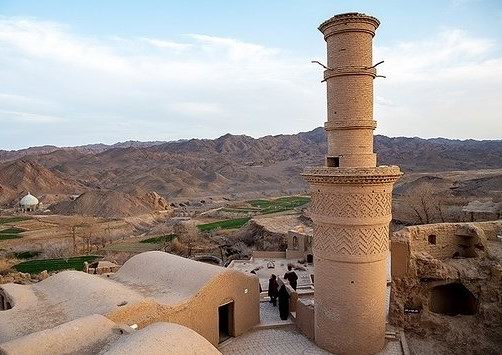Kharanaq
Kharanaq is the name of a village located 60 km from the city of Ardakan, in the province of Yazd, and is an extraordinary example of a rural village structure. Kharanaq, with its ancient history, attracts tourists from all over Iran for its unique location and scenery. This town consists of two parts: the new part, in which more than 500 people live, and the old part or Kharanaq castle that until recently housed the same inhabitants, but was left uninhabited about 30 years ago due to erosion. Given the presence of iron, barite, zinc and granite mines, Kharanaq and its surroundings are one of the most important economic centers in the country. This town has been called Kharanaq by the locals, whose meaning is the birthplace of the sun.
Kharanaq Castle
The most important attraction of the town of Kharanaq is its castle. It is a valuable historical monument with an area of approximately one hectare, and is known as one of the largest rural residential castles in Yazd province.
The fortifications of this castle date back to Sassanid times and around 1800 years ago, signs of life would also be found dating back more than 4500 years. Important features of the Kharanaq Castle construction include the building’s dense framework, the narrow covered corridor, the use of heat exchange materials, and adaptation to environmental conditions.
The fence that surrounds the castle defines a well protected area. This fence, together with the towers, increased the defensive strength and security of the castle. Six watchtowers include a tower to the north and another to the southwest of the castle and another four in the western part that are connected to the body of the castle. As soon as you enter Kharanaq Castle, the narrow paths, arcades and passageways typical of the alleys give the feeling that one can get lost at any moment.
This system also served to surprise thieves and bandits and, therefore, stop them from reaching a certain destination easily. One of the alleys is known as the Gorg (wolf) alley, designed to direct thieves into this alley and fight them. The lower part of the houses of this castle does not have doors or windows that open to the outside of the castle, ruling out any danger.
The structure of the castle houses
There are 80 houses in this castle, most of which consist of two or three floors, and the design of each of them is in line with the economic capacities and social status of its inhabitants. The brick and mud walls, the vaulted roofs and the use of fiber, wood and straw beams are the characteristics of these houses. In these houses a mixture of mud and lime was used to level the floor of the rooms, straw mortar, on the other hand, to cover the exterior surfaces of the buildings and plaster to decorate the walls of the rooms, corridors and porches. Unlike houses in hot, dry climates, most houses do not have a patio, except for a few. The basement of the houses was used to store livestock and poultry, and in some houses this space was also used to store fodder and grain. Communication with the houses was not possible except through the inner passages of the castle and the houses are not interconnected with each other.
Kharanaq Caravanserai
In the village of Kharanagh there is a caravanserai whose construction dates back to the Sassanid period. After the destruction of this caravanserai, over time, it was restored by order of Mohammad Vali Mirza, son of Fath Ali Shah in the Kayar period, and continued to be used as the prince’s inn.



Comments